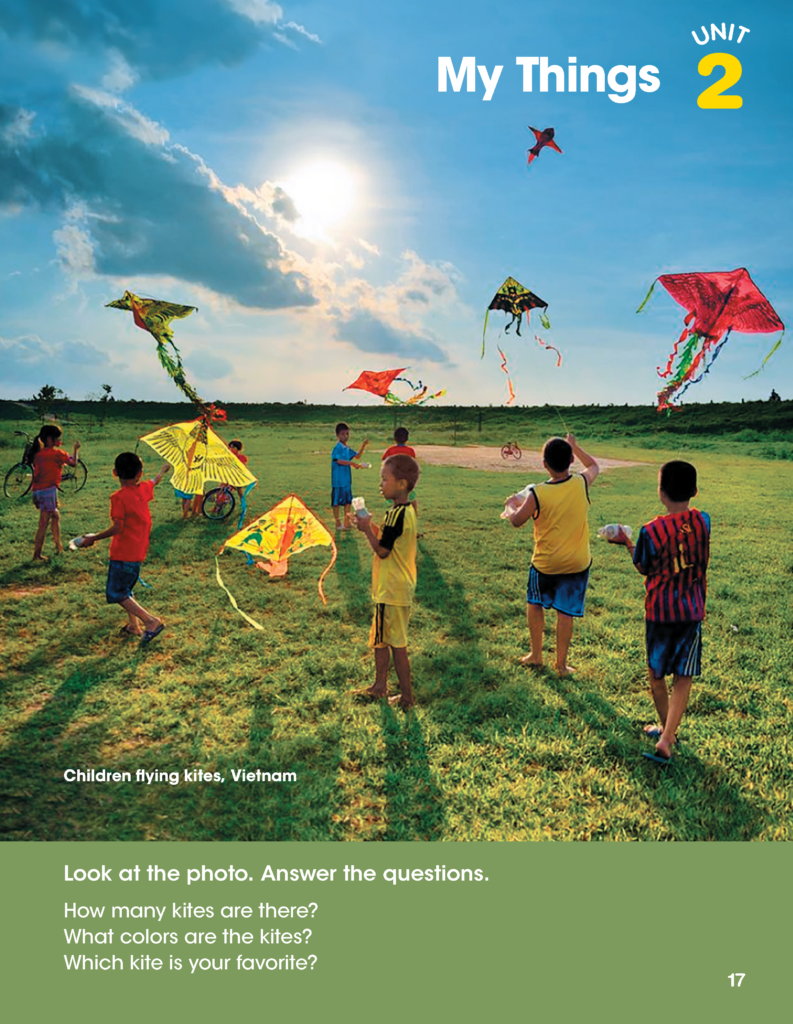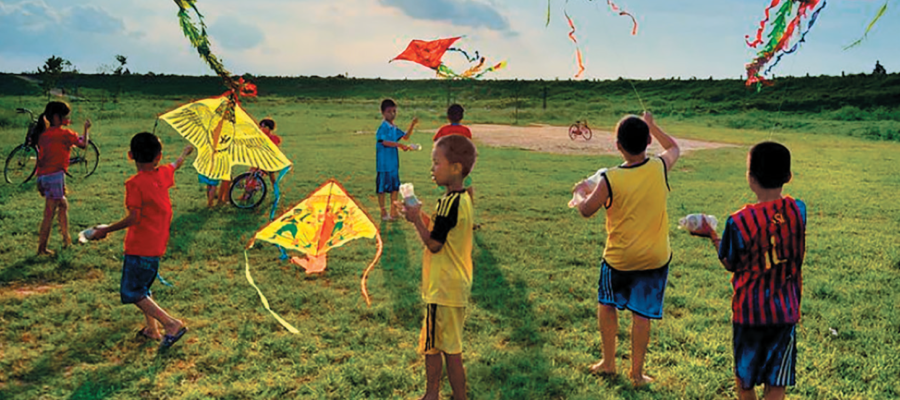Each month in this blog post series, Katherine Bilsborough offers five practical and engaging classroom activities which all use the same photo as a starting point. The ideas can be adapted to work with all ages and levels and are designed to recycle language in an engaging way while developing a range of key skills for this age group. We encourage teachers to try out the ideas below and to write and tell us of any other ideas you have for using each month’s image.
All photos are from the pages of National Geographic Learning’s new primary coursebook, Look!
My things!

This photo shows children in Vietnam. They are playing outdoors with kites. If you have a good idea of how to use it in a classroom, write a comment sharing your ideas in the blog below.
1. Look and point! Adjectives game
Photos of outdoor scenes with people are a great way to practice adjectives. In this activity, learners have to listen, understand and point. They don’t have to produce any language themselves. This makes it an ideal activity for younger learners.
Put learners into two (or more) teams with an equal number of members. Display the photo and ask learners to look carefully and think about what they can see. Then give pointing instructions to each team in turn. One person from the chosen team comes up to the board and points. Award a point for each correct response. The winning team is the one with most points. This kind of game often ends in a draw but the game element adds to the motivation. Give instructions that include an adjective.
Suggested instructions:
Point to something: round/long/short/red/white/blue/yellow/green/high/low dark/light/heavy/near/far
Point to someone wearing something: long/short/yellow/red/striped/comfortable
2. Look, think, draw and present!
Photos of familiar objects such as toys are a great prompt for recycling vocabulary. In this activity, learners have to look, think, draw a kite and present it to the rest of the class using a simple model.
Display the photo and invite learners to look and think about it for a minute. Then explain that you are going to describe one of the kites. Read aloud the description below.
This is my kite.
My kite is yellow.
My kite is small.
My kite has two long ribbons.
One is yellow and one is orange.
Look at the picture on my kite!
There is a girl
And there are two boys.
The colors are green, red and blue.
This is my kite.
Write the description on the board, underlining the words in bold. Check that learners understand the text.
Explain to learners that now they are going to draw a kite. Give learners a limited time (no more than 5 minutes) to think about the design of their kite. This thinking stage is important and shouldn’t be skipped. You could encourage learners to share their ideas in pairs or small groups. This could be done in L1 if necessary.
Learners draw and color their kites. Then they use the model text on the board to give a short presentation. Show learners how they can use the same skeleton text, just replacing the underlined words with their own. Allow time for learners to prepare and to think of the words they need to give their presentation. Encourage them to make notes.
Optional follow up: Learners can write a description of their kites using the model provided. Drawings and texts of this kind make beautiful classroom displays.
3. Look, think and write! (past simple)
Photos are ideal prompts for writing. By focusing on the context of the photo, you can easily come up with an idea for a meaningful, ‘real’ writing task.
This photo of children playing with kites is perfect as a lead-in to a simple letter or email activity. First, display the photo and tell your class to imagine they were here with the other children. Explain that this is a photo of a class trip to the park. They should imagine the place and the context, think about what the experience was like, who they were with, how they felt and any other details. Then write a skeleton letter or email on the board for learners to copy and complete or some simple prompts for more confident learners. This activity practices past simple verbs.
Suggested skeleton:
Dear…,
This is a photo of our class trip last week. In the photo you can see me and my friends …, … and … We are playing with … in a park.
The park was … with lots of …
The weather was … and we had a … time.
Later we had a picnic. We ate … and … and we drank …
We arrived home late, at …!
I hope you like the photo.
From …
4. Look at my friend! Imagining and telling
Children have great imaginations and an image of children of a similar age, like this, is a great resource for encouraging children to stretch their imaginations in creative and fun ways as they imagine they are one of the children in the picture.
By changing the instructions you give and grading the language you use, you can adapt the activity for different levels. Learners listen to a model and are then asked to imagine and say.
Display the photo and engage learners by asking a couple of questions about it.
First ask some simple questions that require no imagination: What can you see? Where is it? Then ask questions that require learners to guess. Point to a child and ask Who is this? How old is s/he? Indicate that you expect the children to invent the answers using their imagination and coming up with believable responses based on making comparisons with their own experiences. Finally, encourage them to stretch their imagination by asking more abstract questions. Point to one child and ask: How is s/he feeling? What is s/he thinking? Then point to two children and ask How are these two children related? Are they friends? Are they from the same family? After each question, respond positively by saying things like I think you are right. Yes, that sounds true! Ask several learners to answer each question, making sure that everyone has the opportunity to share their ideas and nobody is left out.
Model a final speaking task. Point to a child in the picture and talk about him/her for a minute. Use your voice and gestures to sound convincing.
Suggestion:
Look at this boy. He is my friend. His name is Jack and he is eleven years old. Look at his kite! The kite is a present from Jack’s grandpa. Jack is happy today because he is playing outdoors. He is with his friends from school. Look (pointing). This is Jack’s cousin. His name is Carlos and he is ten years old.
Explain that you want the children to choose a child from the photo and pretend it is their friend. They should make a few notes to use as prompts. Then they can take turns to talk about their friend. This can be done in pairs or small groups or one by one as a whole class activity.
Note: Write this skeleton on the board for children to use as a model.
Name: __
Age: __
Kite is a present from: __
Feeling: __ because: __
With: __
Other person: __
Age: ___
5. Look and say! An alphabet game
Alphabet games are a great way of recycling language learned in previous lessons. Write the 26 letters of the alphabet (A-Z) on the board in a column. Encourage children to say the letters as you write them. Then explain to the children that you are going to show them a photo and ask them a series of questions. Some questions will refer to the photo directly, others will be less direct. Each answer will begin with a different letter of the alphabet, from A to Z.
Write the letters A to Z on separate pieces of paper or card and place them inside a bag or box so they cannot be seen.
Organize children into two teams to play the game and appoint team leaders.
Team leaders take turns to take a letter from the box. They should say the letter aloud. Ask the question that corresponds to that letter and give the team time to share their ideas before the team leader provides an answer. If the answer is correct, award the team two points. If it is incorrect, offer the question as a ‘bonus’ to the other team. If they can answer correctly, award a bonus point (one point) before asking the team their own question.
Continue until all the letters are used up. Some of the letters have no questions. If a team picks one out, they get a free point. The team with the most points wins.
A What time of the day is this? (afternoon)
B What kind of transport can you see? (bikes)
C What can you see in the sky? (clouds)
D What pet does the girl in red have at home? (dog)
E Which large animals live near this park? (elephants)
F What language are these children speaking? (French)
G What are the children standing on? (grass)
H How do the children feel? (happy)
I Free point!
J What do these children have for breakfast on their toast? (jam)
K What toys the children got? (Kites)
L What are you doing with this photo? (Looking!)
M Which small animal is watching these children? (mouse)
N How many children are in the picture? Look carefully! (nine)
O What kind of juice do these children like? (orange)
P What is the boy in yellow’s favorite school subject? (P.E.)
Q Free point!
R What appears in the sky sometimes – it has seven colors? (rainbow)
S What are the children wearing? (shorts)
T What kind of transport did the children use to go to the park? (train)
U What can these children use to stay dry if it rains? (umbrellas)
V Free point!
W What color is the sun in the sky? (white)
X Free point!
Y What color kite is popular? (yellow)
Z Free point!



Excellent ideas,simple and practical.
Thanks for shaning and creating them.